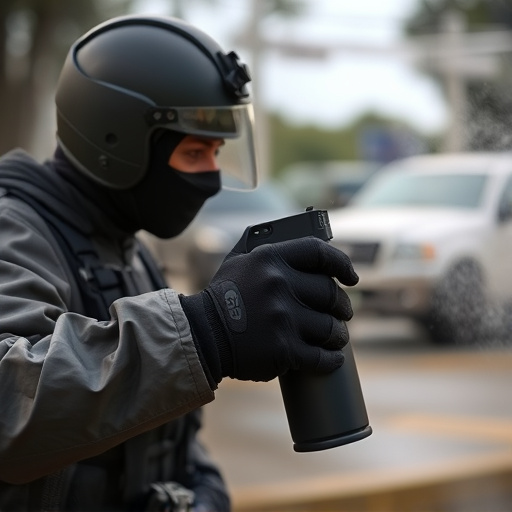Storing pepper spray while traveling requires careful consideration of safety and legal aspects. Keep it cool, dry, and protected from sunlight, heat sources, and interacting substances to maintain effectiveness. Store the spray in a secure, closed container made from non-porous materials, away from direct sunlight, extreme heat, and moisture. Be aware of local laws and international regulations regarding pepper spray carriage, check destination country rules, and familiarize yourself with airline policies to ensure compliance and safety during travel.
“Discover the revolutionary power of Capsaicin-based inflammatory crowd control sprays in this comprehensive guide. We explore the science behind capsaicin’s anti-inflammatory properties, its effectiveness in crowd management, and why it’s a preferred choice for security professionals. From understanding its benefits to navigating safe storage practices while traveling, we cover everything you need to know. Learn about regulatory considerations and essential tips for storing pepper spray, ensuring your travel safety and peace of mind.”
- Understanding Capsaicin and Its Anti-Inflammatory Properties
- Benefits of Using a Pepper Spray for Crowd Control
- Safe Storage Practices for Pepper Spray While Traveling
- Regulatory Considerations and Travel Safety Tips
Understanding Capsaicin and Its Anti-Inflammatory Properties
Capsaicin, the active compound found in chili peppers, has long been recognized for its spicy sensation and potential health benefits. Beyond its ability to stimulate taste receptors and cause a burning feeling, capsaicin possesses powerful anti-inflammatory properties that make it a promising candidate for various medical applications. When used topically, capsaicin has been shown to reduce inflammation associated with conditions like arthritis, neuralgia, and even skin conditions such as eczema and psoriasis.
In the context of crowd control, a spray containing capsaicin offers an innovative approach to managing chaotic situations without resorting to traditional chemical agents or force. By leveraging its anti-inflammatory properties, this pepper spray can effectively disrupt and disperse crowds while minimizing potential harm. Additionally, proper storing of capsaicin-based pepper spray while traveling is essential. It should be kept in a cool, dry place, away from direct sunlight, heat sources, and other substances that might interact with or degrade its active ingredients, ensuring its effectiveness remains intact when needed most.
Benefits of Using a Pepper Spray for Crowd Control
Using capsaicin-based inflammatory crowd control spray offers several significant advantages in public safety and security. Unlike traditional crowd control methods that often involve physical force or chemical irritants, pepper spray is a non-lethal option with a rapid effect. It temporarily incapacitates individuals, allowing for safer management of large gatherings, protests, or riotous situations. This makes it an invaluable tool for law enforcement agencies, security personnel, and even civilians who need to defend themselves in high-risk environments.
When considering storing pepper spray while traveling, it’s crucial to ensure its safe and legal transport. Many countries have strict regulations regarding the carrying of such irritant agents, so understanding local laws is essential. Proper storage involves keeping it out of reach of children, securing it in a cool, dry place, and ensuring it remains sealed to prevent accidental activation or leakage. This attention to detail not only maintains the effectiveness of the spray but also ensures compliance with travel regulations.
Safe Storage Practices for Pepper Spray While Traveling
When traveling with capsaicin-based inflammatory crowd control spray, proper storage is paramount to ensure safety and efficacy. It’s crucial to keep the spray in a secure, closed container, preferably made from non-porous materials like metal or robust plastic, to prevent any accidental activation or contamination. Store it away from direct sunlight, extreme heat, and moisture to maintain its potency. Travel-sized containers are ideal for convenience, but ensure they meet safety standards and comply with airline regulations.
During transit, keep the spray in an easily accessible, designated area of your luggage, away from flammable materials or other potential hazards. Never leave it unattended or place it in checked baggage. Remember to familiarize yourself with local laws and regulations regarding the carriage of pepper spray, especially when crossing international borders, as restrictions may vary significantly.
Regulatory Considerations and Travel Safety Tips
When carrying a capsaicin-based inflammatory crowd control spray while traveling, regulatory considerations come into play. Different countries have varying laws and regulations regarding the possession and transportation of pepper spray. Always check the local guidelines before packing it in your luggage or carrying it on your person. Ensure that you have the necessary permits or documentation to legally possess such a device in your destination country.
Storing pepper spray while traveling is paramount for safety. Keep it securely in its original packaging, and never mix it with other liquids in your carry-on bag to avoid potential leaks. Store it separately, preferably in a cool, dry place, and ensure that it remains out of reach of children or anyone who might misuse it. Familiarize yourself with airline policies on transporting pepper spray, as well as any restrictions at your destination, to avoid any unforeseen issues during your journey.
Capsaicin-based inflammatory crowd control sprays offer a unique approach to public safety, leveraging natural compounds for effective crowd management. By understanding capsaicin’s anti-inflammatory properties and adhering to safe storage practices while traveling, we can ensure these specialized aerosols remain both efficient and compliant with regulatory standards. Remember that proper handling and responsible use are key, especially when considering the global impact on travel safety.
